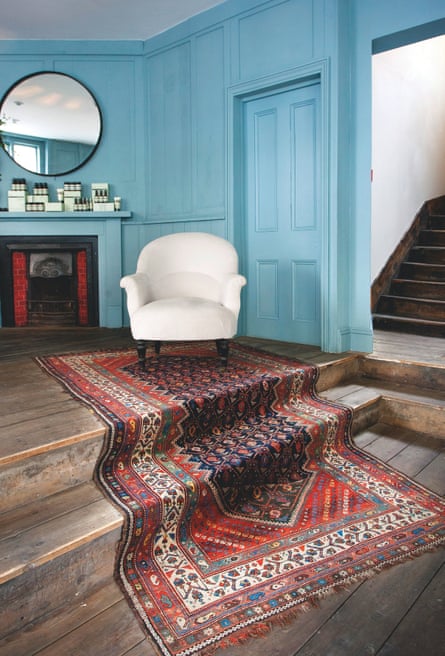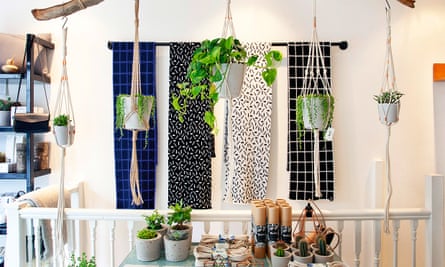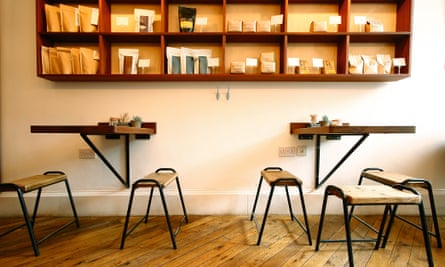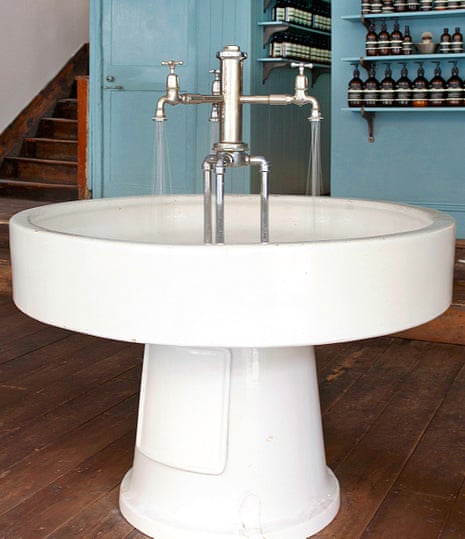Ideas for a bathroom
Of Aesop’s 11 UK branches, its Richmond store, in a three-storey, 18th-century town house, feels the most homely. “When we stripped back the premises, we uncovered wooden panelling, fireplaces and sealed doors,” says Deidra Hodgson, who oversees the design of the Australian skincare brand’s UK stores. “We discovered a domestic space, so we took that as our starting point.” For the walls, she chose a calming heritage blue (Sanderson’s Blue Clay), “which already felt aged and patinated”, with eccentric accents not normally found in bathrooms.
The Guardian’s product and service reviews are independent and are in no way influenced by any advertiser or commercial initiative. We will earn a commission from the retailer if you buy something through an affiliate link. Learn more.
The focal point of the store, as in all Aesop branches, is the sink – in this instance, a reclaimed, circular, fish-scaling sink sourced from the north of England. “There are a lot of amazing reclaimed sinks out there,” Hodgson says. “You can find everything from simple butler sinks to wall-mounted French enamel ones, lime and sandstone, beautiful salt-glazed and terracotta sinks. And they are usually cheaper than new.” (Try englishsalvage.co.uk or lassco.co.uk.)

A secondhand ladder is propped in one corner (this could serve as a towel rail at home); the soft furnishings are from the French House, and vintage rugs cascade, off-set, down reclaimed pine steps (try allthehues.co.uk for similar rugs). “Their angles reflect the slope of the building and its irregular doorways,” Hodgson says.
The lamps are repurposed sun lamps from the 1950s and 60s, bought from an architectural lighting restorer (try 1stdibs.com), while the shelving brackets are recast from an original pair of Victorian cistern brackets picked up at Kempton antiques market.
When stripping the premises, Hodgson found in the basement an old wooden trunk full of black-and-white family photographs. That trunk now takes pride of place on the shop floor, and the photographs have been framed and hung on the walls. “I believe in having pieces in your home that have relevance not only to your life, but to the building itself,” she says. To complete the feeling of domesticity, a local cat visits the store each day, following the sun around the building.
Ideas for a hallway

Triangle homewares store in east London is living proof of how just a few creative ideas can transform a relatively neutral interior. “We’ve gone for clean lines, with a nod to bold, geometric shapes and a strong mid-century influence,” co-founder Victoria Mullen says. The plywood floor is painted in the palest green – Lichen by Farrow & Ball: “It has a soft, vintage feel that works well with the plants in the shop, of which there are many.”
A sculptural branch hangs dramatically above the staircase to the lower ground floor; it was dragged back by Mullen from a dog walk on Hackney Marshes and is used to showcase their plant hangers, which are suspended on simple S-shaped hooks (from a DIY store, sprayed black).
Elsewhere, stock is displayed in vintage white metal and glass cabinets sourced from Kempton antiques market and fabric is draped over a wall-mounted rail (a giant dowel sprayed black) that runs the length of the wall above the stairwell. “This is a great thing to try at home,” Mullen insists. “It’s important to push the boundaries of what’s considered art: if you love it, hang it on the wall.”
Ideas for a small apartment

The diminutive Fortitude coffee shop in Edinburgh opened 18 months ago, when owners Matt and Helen Carroll took over the lease from a cobbler. The couple are now doing their bit for Edinburgh’s burgeoning coffee culture. “There’s a nice little scene brewing,” says Helen, who oversaw the changes to the interior. “We did everything we could ourselves,” she adds of the cafe, which is in one of the city’s stone-clad town houses. Given the tight proportions, the couple have maximised table, storage and shelving space with custom-made furniture, in aroca hardwood backed with birch ply. The floor came from an old church just outside the city (try retrouvius.com for similar salvaged flooring), with the pine boards deliberately cut into a chevron pattern that directs customers towards the room’s focal point, the counter.
Most of the tables are wall-mounted on brackets, which helps to keep the floor space uncluttered, while the vintage school chairs and stools came from Peppermill Antiques. The circular table in the window is a plain piece of aroca with hairpin legs attached: “It’s a great way of making a plain surface look fab,” Helen explains. “You can buy a set of hairpin legs off eBay and just screw them into the surface. They are incredibly cheap and come in amazing bright colours.”
Bare filament bulbs dangle from orange and black flex, and are strung up from hooks and brackets sourced from Urban Cottage Industries; the enamel shades are from labourandwait.co.uk. Flowers are arranged in vintage milk bottles (all eBay finds) and a reclaimed wire mesh letter rack, used to stash the weekend papers, is from lovelyandco.co.uk.
Ideas for a dining kitchen
The two-storey Cow & Co cafe in Liverpool’s Cleveland Square opened in 2013 – a bricks-and-mortar embodiment, done on a budget, of founder Benji Holroyd’s design agency. It sells breakfasts, lunches, deli items and homewares, and is the largest independent magazine retailer in Liverpool: “A kind of relaxed library,” Holroyd says.
The space is utilitarian: shelves are constructed of birch ply and fitted with white key-clamp scaffolding or filled with potted succulent plants – “Because they look good and are very hard to kill,” Holroyd says. Outside, customers tuck into their bacon, spinach and taleggio sandwiches on communal vintage German beer garden tables (find them at lovelyandco.co.uk). Inside, the dark walls are painted Hicks’ Blue from Little Greene, with green factory lights for contrast (try trainspotters.co.uk). The counter is tiled in small hexagonal tiles (find similar at toppstiles.co.uk), an eye-catching design that would be perfect for a kitchen island.
An upcycled industrial trolley serves as a drinks station. It was sourced from IBS in Liverpool, a five-storey furniture warehouse that houses precarious mountains of office and school furniture from the 1950s and 60s. “It’s our first port of call whenever we do a refit,” Holroyd says; his agency is responsible for around 70% of the city’s bar and restaurant interiors.
From the minimalist white pipe wall lamps to the own-brand rustic hand-thrown stoneware pottery, much of what you can see in the cafe is available to buy direct. It’s also what Holroyd has in his own home. “When we first opened, we were pigeonholed as Scandinavian cool, but that was never the intention. I think the shop has a living-room chic about it. Customers come here to relax, to stare out of the window over a cup of tea. It has a peaceful vibe. It’s not glitzy: it’s just beautifully done, and done on a budget.” All of which makes the aesthetic not only covetable, but achievable at home, too.

Comments (…)
Sign in or create your Guardian account to join the discussion